HCG Injections

The basics about hCG Injections
After reading this page, you’ll have a very good understanding of hCG injections, how to use them and where to buy them.
- What is hCG?
- Types of hCG
- Medical Usage for hCG Injections
- HCG Fertility Dosing
- HCG Diet Dosing
- Get Organized Before Injecting
- HCG Injections Procedure
As with all of the information on our site, we stongly suggest you go through it all and learn as much as you can.
What is hCG?
“HCG” really is just is the short form for “human chorionic gonadotropin.”
Did you know that hCG is a hormone? And that it’s naturally produced in both males and females, by the pituitary gland, the colon and the liver?
It’s also produced naturally in the placenta of pregnant females and during pregnancy, stimulates the production of progesterone to help maintain a pregnancy. Generally speaking, this is the more commonly known or heard of form of hCG.
In males, hCG helps maintain and restore production of testosterone in the testes.
For more detailed information about hCG, visit our page “What is hCG/Human Chorionic Gonadotropin ?”
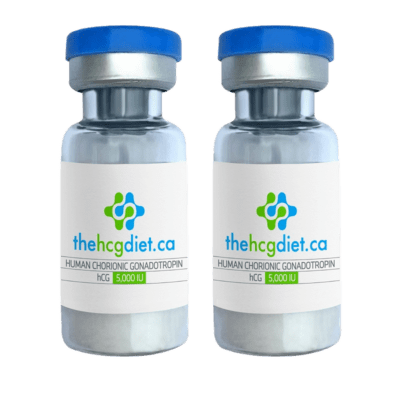

Types of hCG
There are 2 types of hCG that are used in medicine these days:
- The first one is “Urinary hCG” (uhCG) which is produced in the placenta of pregnant women.
This is the most common type on the market. Brand names that are found in North America today include Pregnyl and Novarel. HCG is Measured in International Units (IU) which is not a weight or voleme measurement.
2. The second type is “Recombinant hCG” (rhCG) which is derived from the ovarian cells of hamsters or can be synthesized in a lab.
The most common Brand name of this type of hCG we see on the market in North America would be Ovidrel. We find this is a bit confusing as it’s not from a human! It’s measured in micrograms (mcg) which is a measurement of weight.
Medical Usage for hCG Injections
HCG has been used to treat common medical issues, in both men and women for around 100 years!
But first, it’s derived from the urine of pregnant females. The urine is then processed to extract the hCG and then it’s turned into a dry powder.
This dry powder is then reconstituted with a sterile or bacteriostatic water. This now liquid solutionis used via an hCG injection for delivery to the patient.
HCG injectables can be used for the treatment of infertility in women and to help stimulate production of testosterone in men. When used in men, the hCG can increase sperm production over the course of treatment.
As well, it’s known around the wrold as an effective treatment for weight loss. HCG diet injections for weight loss have been in use since the early 1930’s by the world renowned endocrinologist Dr. Albert T.W. Simeons.
When buying or using Urinary hCG (uhCG) you’ll find it available in quantities of 2,000, 5,000, 10,000, and 20,000 IU.
Recombinant hCG (rhCG) is not as common in use, but is available in 250 and 500 micrograms (mcg). 250 mcg is approximately 6,500 IU.
Depending on what it’s being used for, you’ll see that usage, dosing amounts will be quite different.
HCG is typically measured in International Units (IU) and dosing amounts for fertility will differ between patients, based on a few factors. One of those factors being the current levels of hCG in the patient’s body.
HCG Fertility Dosing
In Females, when used as a fertility treatment, hCG injections can help stimulate the product the production of eggs in the ovaries.
This increase of hCG can help trigger ovulation, which then can help increase the chance of becoming pregnant.
10,000 IU is the most common injection amount that’s prescribed by doctors for infertility. But hCG injections can range anywhere from 2,000 IU up to 20,000 IU again, depending on the patient.
In successful hcg treatments for infertility, ovulation will typically occur 6-9 hours after the hcg has been injected.
In males, as a fertility treatment to increase sperm counts, dosing is also dependent on current hCG levels in the patient.
A typical dosage for males is 1,000-2,000 IU, and the hCG is injected 3 times per week for 6-12 months.
HCG Diet Dosing
When used for the hcg diet, “uhcg” is the type prescribed and that one comes in powdered format. The powder is then mixed with a carrier solution and kept refrigerated when not being used.
As wtih all pharmacuetical products, the dosing amounts of hcg injections for weight loss can vary, usually depending on the size of the person using them.
Dr. Simeons found in his years of treating obesity that 125 IU daily was quite sufficient for the majority of patients to successfully lose weight.
He also cautioned that injecting more than 200 IU each day can have a reverse effect and when the patient stopped the hCG diet injections, they could in fact gain weight.
We always like to suggest starting at 125 IU as that has been the standard for almost a century!
If we see there are issues with noticeable daily weight loss, we might suggest increasing the daily dose to either 150 or 175 IU.
However, these higher amounts are typically reserved for people who have 100 pounds or more to lose.
Early research also suggested a maximum of 23 injections in a round of treatment. Further findings over the years now suggests the maximum number of days of continuous injections be capped between 50-60, depending on results.
Get Organized Before Injecting
Before you begin injecting, follow these steps:
1. Organization!
Get everything together that you’ll need, including the solution, an injections syringe, an alcohol wipe and a sharps container for your used syringe. (Never reuse syringes! They are one time use only! And DO NOT share syringes with anyone, even your spouse!)
2. Cleanliness!
Make sure you wash your hands with soap and water for at least 20 seconds, then dry them in a clean, dry towel. Then, tear open an alcohol swab and clean the injection site. Following that, you can clean the rubber lid of your solution vial and clean the syringe needle. And then make sure everything is dry before injecting.
3. Fill the syringe.
To begin, push the plunger of the syringe all the way in, then insert the syringe needle into the vial.
Now slowly begin to draw out the required amount as noted in the instructions for the product you’re using.
This can vary widely, depending on what you’re uising the hCG injection for.
After you’ve filled the syringe with the required amount, remove it from the solution, point it towards the ceiling and gently tap the side of the syringe to help move any air bubbles to the top.
Then, very slowly and gently, push the syringe plunger in just enough to push the air bubbles out.
4. Prepare for Injection!
If you’re injecting subcutaneous, pinch an inch or two of fat, line your syringe up at a 90 degree angle to the area you’re injecting into and push the needle into the fat.
The needle length will be short, so don’t worry about it going too far.
For an intramuscular injection, no pinching is required, just insert the needle into the muscle at a 90 degree angle.
5. Inject the solution.
Slowly and gently push the plunger in until it bottoms out and all the hCG solution has entered your body.
The, while continuing to pinch (for subcutaneous), slowly pull the needle out of your body.
Try your best not touch, rub or scratch the area after removing the needle.
And always remember that slow and steady wins the race! There’s no need to try to do this super fast.
6. Dispose of the syringe.
After your injection, if you have a “sharps container” just toss it in there.
If you don’t, just save a jam or pickle jar or something with a lid you can close. And you’re done!
HCG Injections Procedure
Now that you’ve learned a thing or two about hCG, you’ll need to know how to go about injecting it.
Important to note! It’s not at all difficult to inject and once you’ve done it a time or two, it gets super easy and the whole procedure should take less than a minute.
After the hCG is mixed with the sterile or bacteriostatic solution, you’ll use a small syringe (typically the same type used for insulin injections) to inject the solution into your body. The amounts are extremely small.
There are two ways to inject hCG into your body. The most most common method is called subcutaneously (meaning “beneath the skin.)
The second method used for injecting is called intramuscular (meaning “injection into muscle”) and is the less common method.
Subcutaneous hCG Injections
For subcutaneous injections, you can inject into your belly fat (most common with hcg diet injections) the fat in the front of your thigh, or the fat at the back or side of your upper arm. The upper arm is not the easiest to do by yourself, so it’s the least used.
In the subcutaneous belly method, you’ll pinch a small section of fat an inch or so away from your belly button and insert the syringe there. The syringe can be at an angle to your body from anywhere between 45 and 90 degrees.
After you’ve gently pushed the syringe tip into your belly fat, gently press in the plunger of the syringe to move the solution into your body.
You can use the same pinch method for the thigh and upper arm locations if you’re injecting there.
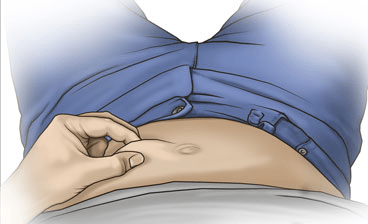

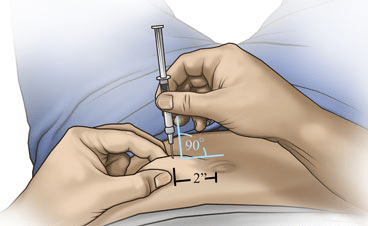

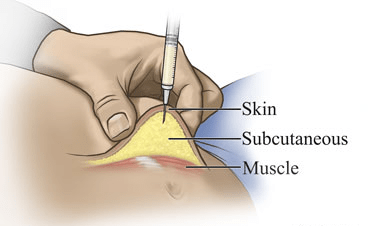

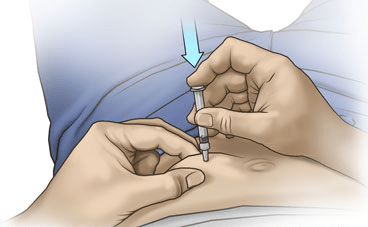

Intramuscular hCG Injections
For Intramuscular injections, the upper outer arm or the upper outer buttocks (side of your hip) are where you’ll inject.
You’ll be inserting the syringe needle directly into muscle and this could create a bit of pain or discomfort.
For the upper outer arm, it’s injected into the area just below the top of your shoulder, on the side of your arm.
Most of you would be familiar of an intramuscular injection here when (or if) you’ve had any vaccinations in the past.
For the upper outer buttock, the injection site is the top part of your outer hip (side of your body.)
Intramuscular injections can be a bit more difficult to do by yourself, so a helper is a good suggestion.
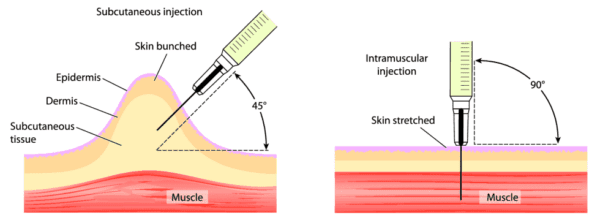

And that’s it! Now you know about hcg injections, what they are, what they’re used for and how to inject properly.
Feel free to share this page so others can educate themselves!

